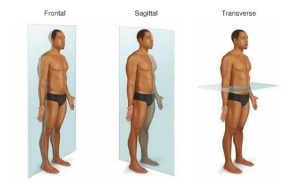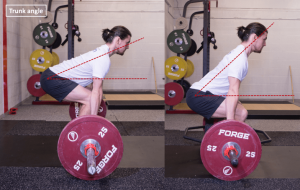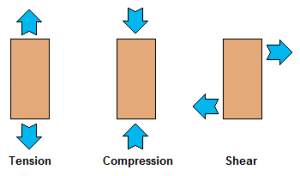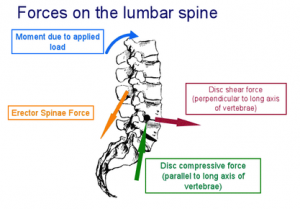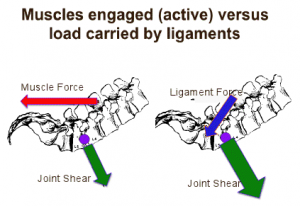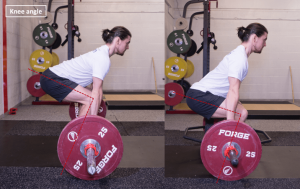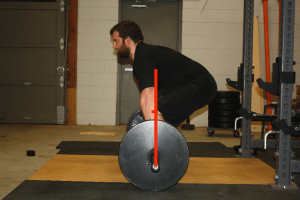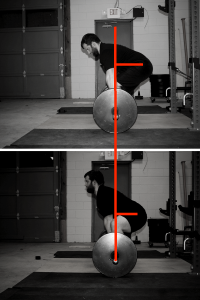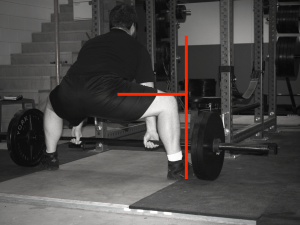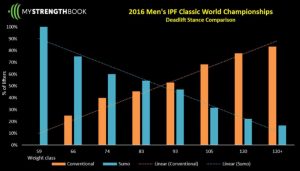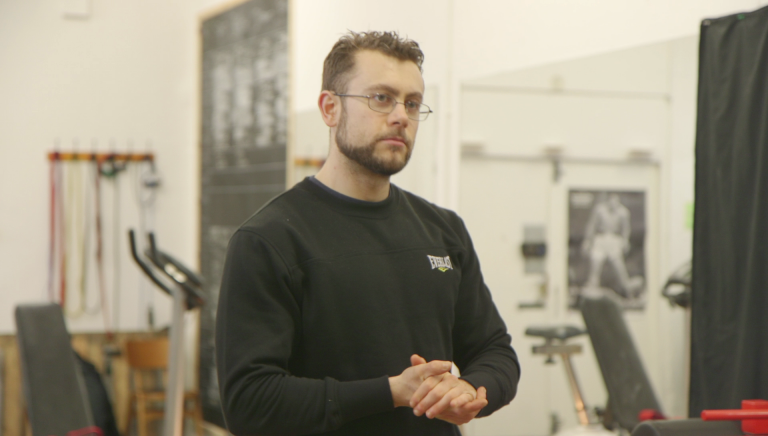The Deadlift; A Bio-Mechanical Assessment
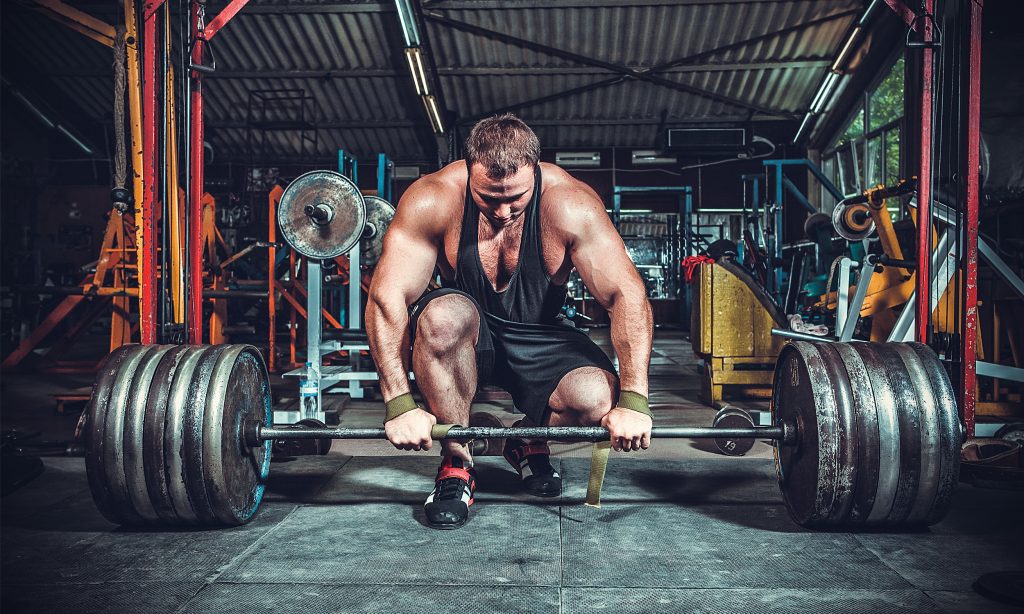
Introduction
The two main styles of barbell deadlift that have been explored in the research and which are contested in the sport of powerlifting both use the straight bar and are the conventional and sumo styles. The conventional deadlift style uses a narrower stance of around 32 – 33cm compared to around 65 – 70cm in the sumo style (Escamilla et al. 2000; Escamilla et al. 2002) and involves a placement of the hands on the barbell inside the stance feet. The conventional style is used more often than the sumo style by powerlifters in heavier weight classes (>90kg) while lifters in lighter weight classes seem to display a relatively equal tendency to use both styles (Escamilla et al. 2000). Both techniques have pros and cons, and most people tend to find that one is easier than the other.
Both techniques have been used effectively in elite power lifting competition. Conventional style places a large emphasis on the use of the erector spinae muscles because in this position the trunk is normally flexed forward. Sumo style is performed with a more erect and upright back alignment that allows for greater recruitment of the hip muscles to perform the lift (Piper & Waller, 2001).
The sumo lift is considered to be the more bio-mechanically efficient lift of the both techniques (McGuigan & Wilson, 1996). It is suggested that bar travel is minimised with a shorter stroke and aids the ability to recruit a greater number of muscle fibres from the posterior chain. Studies have indicated that sumo style deadlifting can reduce bar travel by nineteen percent (McGuigan & Wilson, 1996). Peak power in both deadlifts appears to occur between 30 – 50% of 1RM. The effect of relative load on rate of force development is unclear but faster bar speeds are associated with greater rate of force development.
Studies by McGuigan & Wilson (1996) have also indicated that in elite competitive powerlifting the majority of world records are held by lifters using the conventional style. Sumo style deadlifting has not produced as many world records but has performed greater lifts in terms of relative body weight. This gives rise to the suggestion that conventional style deadlifting may be suited to lifters of larger body mass with longer arm length and sumo suited to those of smaller body mass, with shorter stature.
The Deadlift – Musculature & Basic Technique
The conventional style primarily involves the use of the erector spinae, trapezius, quadriceps (as a stabiliser) and hamstring muscles (Stone & O’Bryant, 1987). Further analysis of the conventional deadlift indicates that the gluteal, latissimus dorsi, teres minor subscapularis, infraspinatus, supraspinatus and biceps brachii all assist with the lift to some degree (Farley, 1995).
Conversely, sumo deadlifts are harder on your quads. When the bar brakes the ground, knee moment was approximately 3x higher for sumo deadlifts than conventional deadlifts (Escamilla et al. 2000). This was also reflected in EMG data. EMG readings for the quads (vastus lateralis and medialis) were higher in the sumo deadlift than the conventional deadlift (Escamilla et al. 2002).
Keeping the load as close to the body as possible should assist with increasing the mechanical advantage for greater force production (Stone & O’Bryant, 1987). In contrast to this, some literature has suggested that keeping the load too close to the body may cause excessive drag and friction against the body that may decrease the efficiency of the lift.
For the conventional style Daniels (2003) indicates keeping the back flat and placing the hips below the half squat position. This position is said to put the initial load of the pull on to the quadriceps muscles without placing undue stress on the lumbar region of the spine (Groves, 2000).
Other Differences
One of the main differences in the two deadlift techniques – the forward flexion during the conventional deadlift, makes the lockout section of the lift harder. Therefore, this would seemingly place more importance on the gluteal muscles, which help during this phase.
Interestingly, comparing Olympic weightlifters and untrained control subjects during an isokinetic machine deadlift test, Noe et al. (1992) found no differences in gluteus maximus muscle activity between the two groups. They noted that the peak in gluteus maximus muscle activity during the isokinetic lift occurred at 83% of lift height, which was after the point at which peak force was produced at 67% of lift height.
Comparing the effects of deadlift technique, Escamilla et al. (2002) also found no differences in gluteus maximus muscle activity between sumo and conventional deadlift styles.
Planes
To make this section a little easier to understand, you need to understand planes of movement. There are three basic planes: sagittal, frontal, and transverse. The sagittal plane cuts something in half top to bottom and front to back, and it’s where flexion and extension take place. The frontal plane cuts something in half top to bottom and side to side, and it’s where abduction and adduction take place. The transverse plane cuts something in half front to back and side to side, and it’s where rotation takes place.
Here’s a crucial point: abduction, adduction, and rotation are defined by the frontal and transverse planes relative to the torso. Flexion and extension, on the other hand, are defined relative to the bones and joints where they’re taking place.
Most importantly for the deadlift, hip and knee flexion and extension are defined by the sagittal plane relative to the femur. Imagine a plane that cuts your femur in half front to back and top to bottom.
Basic Demands in the Deadlift
There are four basic challenges you need to overcome in the deadlift: a spinal flexor moment, a hip flexor moment, a knee flexor moment, and, obviously, you need to be able to hold onto the bar
Comparing Trunk / Spine Angle in Conventional & Sumo Deadlifts
The spinal flexor moment increases as the horizontal distance (perpendicular to gravity) in the sagittal plane (relative to the torso) between the bar and any intervertebral joint increases.
The more inclined your torso is and the longer your torso is, the higher the spinal extension demands will be. This is the main reason why more conventional deadlifters are limited by back strength than sumo deadlifters – your torso is inclined farther forward at the start of a conventional deadlift.
Comparing the effects of deadlift technique, McGuigan and Wilson (1996), Escamilla et al. (2000) and Escamilla et al. (2001) found that peak trunk angle was more horizontal in the conventional deadlift style than in the sumo deadlift style, by between 5 – 9 degrees.
Typically, the taller the lifter, the further forward over the bar and the more the torso will need to be.
Lower Spine Net Joint Moment
Comparing the conventional and sumo deadlifts, Cholewicki et al. (1991) found that the sumo deadlift style involved smaller L4-L5 net joint moments than the conventional deadlift style.
The sumo deadlift is regularly referenced as being easier on the lower back, and lifters who have lower back issues can often deadlift in a sumo stance when the conventional style has not been possible – at lease without pain. There is no doubting that the spine is extremely important to the lift, and can be injured when the lift is performed with bad form. Let’s have a look at what happens to the spine during the deadlift;
Mechanical terminology
The three directions in which forces are applied to human tissues are compression, tension, and shear (shown in the picture below). In case you are wondering, bending places one side of the object in compression and the other in shear, and twisting (torsion) is just a type of shear.
Terminology for directions of force
For this discussion on lumbar mechanics we do not need to focus on tension as it is as a force that tends to pull a tissue apart and is not relevant to our purposes. Our focus will be on compression and shear. Shear is defined as a force that acts parallel to a surface; in the spine, it can create sliding of one vertebra with respect to another.
In a lift such as the deadlift, the weight being lifted and centre of mass of the upper body and arms are a relatively long way from the vertebrae, and this creates a huge torque (moment of force) about the lumbar vertebrae. Although the vertebrae are a collection of joints, we can visualise that the disc between lumbar vertebrae 4 and 5 is the centre of rotation for this force. The line of action of the spinal erector musculature is a very short distance from the joint centre of rotation (6-7 cm) and hence these muscles must pull on the spine with hundreds of kg of force to lift common loads (and well into the hundreds / thousands of kg when performing heavy deadlifts).
The picture also shows that the line of action of these muscles pulls the lumbar vertebrae together and creates compression between them. This can be hard to visualise, but when you effectively stabilise your lower body against the ground, the lower lumbar vertebrae are “pushed upward” from below and pulled downward by the muscles. This creates large compressive forces (again into the hundreds / thousands of kg when deadlifting).
In addition to creating a torque that wants to rotate the lifter forward (clockwise in the illustration), the load being lifting and weight of the upper body also act downward (gravitational pull). A component of this force acts as shear across the L4-L5 joint. It is this force that can be particularly problematic, as we will soon see.
Anatomy of the lumbar spine
The anatomy of the spine is quite complex. However, to understand the need to maintain normal lumbar lordosis (curvature), all we really need to discuss is the line of action of the erector muscles and some of the ligaments that connect the vertebrae to one another (interspinous ligaments). The picture above shows the line of action of the muscles and you should be able to see that a component of this force acts to counteract the shear force, that is, it balances out the forces acting across the spine. Dr. Stuart McGill, a world-renowned spinal biomechanist from the University of Waterloo in Ontario, identifies two types of shear.
The shear shown in the above picture is called reaction shear and is the result of gravity pulling the load and the upper body downward. The closer your upper body moves to horizontal, the larger this force will be. However, the true shear on the L4-L5 joint (called the joint shear) is the resultant shear force produced by the sum of the reaction shear and the muscle/ligament shear. It is this value, which includes the effect of muscle/ligament forces, that represents the actual shear experienced at the L4- L5 joint. And it is clearly the true shear on the lumbar spine that will determine whether the spinal loading is manageable, or potentially injurious.
The above image does not show ligament forces because if you maintain the natural curvature of your lumbar spine, the spinal erector musculature will create the opposing torque to extend your trunk as you come up from the lift. And, as shown in the picture, a component of this large muscle force will neutralise the shear produced by the load and body mass. The muscle force is predominantly parallel to the spine but also pulls back to counteract the forward shear. Many coaches will tell you that shear on the back doesn’t occur if the back is rigid. This may not be particularly intuitive, but as shown above, it is correct, as the muscle forces offset the shearing effect of the weight (force) of the load and upper body.
So, what happens if you do not keep a rigid, straight back? Dr. McGill has shown conclusively with studies analysing the electrical activity of the spinal erectors that as the lumbar spine becomes fully flexed (rounded forward), the contribution of the muscles to the required torque decreases and the supportive force generated by the ligaments increases. So, in effect, you switch off your muscles and allow your ligaments to support the weight, which is not a good idea.
Although the ligaments of a conditioned athlete are going to be strong, they’re not that strong, and the line of pull of the interspinous lumbar ligaments means they actually add to the shear component. The angle of pull of these ligaments during lumbar flexion is shown in the image below.
In the right-hand picture, you can see that the muscle force is absent and is therefore unable to help reduce the joint shear. Although the ligaments can counteract the load torque (allowing you to lift with a flexed back), the line of action of the ligament force adds to the joint shear, which becomes very large indeed. The bottom line then is, yes, you can often get away with flexing the spine during a deadlift, but only with a significant risk of damaging the lumbar discs.
Some novice deadlifters (and even some of the more experienced ones) think that their shoulders should be behind the bar and that they should be as upright as possible. This appears to be a natural tendency in an attempt to reduce shear on the back, but, as discussed above, this is a mistaken focus.
Posture; it doesn’t have to be close to vertical. Your trunk alignment should be decided by your anthropometry (arm. leg and trunk lengths) and you should focus on keeping a natural flat alignment, as a more vertical rounded back will result in more joint shear than a more horizontal flat back.
Comparing Hip Angle in Conventional & Sumo Deadlifts
The hip extension demands in the conventional deadlift are equally simple – how much weight is on the bar, and how far are your hips behind the system centre of mass (again, generally located over the middle of the foot).
The farther your hips are behind the bar, the harder the lift is for your hip extensors. Although your setup for the lift can influence hip extension demands to some degree, the largest determining factor is simply how you’re built. People with longer femurs and/or shorter arms (all other things being equal) will need to incline their torsos farther forward at the start of the lift, and start the pull with their hips farther behind the bar. This, again, is usually the case with taller lifters.
Comparing the effects of deadlift technique, Escamilla et al. (2000) found that peak hip joint angle was not different between the conventional deadlift and sumo deadlift styles (although peak hip joint angle was non-significantly more acute in the conventional deadlift by around 5 degrees). McGuigan and Wilson (1996) found that peak hip joint angle was more acute in the conventional deadlift style, by around 10 degrees.
Hip Net Joint Moment & External Moment Arm Lengths
Comparing the effects of deadlift technique, Cholewicki et al. (1991), Escamilla et al. (2000) and Escamilla et al. (2001) all found that the maximum hip net joint moment (at the point of lifting the bar from the ground) was not different between the conventional and sumo deadlift styles.
Comparing the effects of deadlift technique, both Escamilla et al. (2000) and Escamilla et al. (2001) found that there was no difference in hip external moment arm length between conventional and sumo deadlift styles.
Comparing Knee Angle in Conventional & Sumo Deadlifts
Knee extension demands are pretty low; odds are very low that quad strength will limit how much someone can deadlift with a conventional stance (feet close together, with the arms outside the knees). The external moment arm for knee extension – the front-to-back distance between the system centre of mass (roughly over the middle of your foot) and the knee joint – is always going to be pretty small because your knees simply can’t track forward very far.
If they go too far forward, your shins will get in the way of the bar early in the lift, either forcing the bar to move forward (which would decrease the knee extension demands while also throwing you off balance), or your knees will need to shift back (which would also decrease the knee extension demands).
If you deadlift with perfectly vertical shins, knee extension demands will be lower than they would be if your knees started over the bar or slightly in front of the bar, but the knee extension demands will be pretty low regardless.
The main role of the quads in the conventional deadlift is simply to anchor the tibia in place and keep the knee extending to counter the contraction of the hamstrings. It is interesting that in all likelihood, the hamstrings themselves provide more resistance for the quads in the conventional deadlift than the weight itself does.
Comparing the effects of deadlift technique, McGuigan and Wilson (1996), Escamilla et al. (2000) and Escamilla et al. (2001) all found that peak knee joint angle was not different between conventional and sumo deadlift styles.
Knee Net Joint Moment & External Moment Arm Lengths
Comparing the effects of deadlift technique, both Escamilla et al. (2000) and Escamilla et al. (2001) found that the maximum knee net joint moment (at the point of lifting the bar from the ground) was greater in the sumo deadlift style than in the conventional deadlift style. However, Cholewicki et al. (1991) did not report this finding, noting that the maximum knee net joint moment was near zero in both cases.
Comparing the effects of deadlift technique, both Escamilla et al. (2000) and Escamilla et al. (2001) found that there was a difference in knee external moment arm length between the conventional and sumo deadlift styles. There was a greater knee external moment arm length in the sumo deadlift style compared to the conventional deadlift style (19.3cm vs. 5.1cm in Escamilla et al. 2000; 13.2cm vs. 3.3cm in Escamilla et al. 2001).
Conventional deadlift image showing the knee extension moment
As you can see, the centre of mass passes almost directly through the knee joint – the knee extension moment will be tiny.
In general, hip extension demands are highest at the start of the lift, and progressively decrease throughout the pull. If you start the lift with your knees over the bar or slightly in front of the bar, your hips may drift back slightly as the bar leaves the ground, momentarily increasing hip extension demands, but on the whole, the first ~1/3 of the lift should be the hardest for your hip extensors.
In the sumo deadlift, knee and hip extension demands are slightly more complicated, but not extremely so (the technical explanation can be a little confusing, but the practical interpretation is pretty intuitive).
For starters, keep in mind that knee and hip extension demands are defined in the sagittal (front-to-back) plane relative to the femur, not the sagittal plane relative to the torso. This is an important point to keep in mind, because it’s easy to compare your hip position from the side in a sumo and conventional stance, see that that there’s less front-to-back distance between your hips and the bar in the sumo stance, and then conclude that sumo deadlifts are way easier for your hip extensors than conventional deadlift.
An image showing the differences in hip distance from the bar in conventional & sumo deadlifts, respectively
However, when you analyse hip extension demands in the sagittal plane relative to the femur, rather than the sagittal plane relative to the torso, it becomes clear that deadlift style shouldn’t (and doesn’t) influence hip extension demands to a huge degree because the distance from your hip joint to the system’s centre of mass (which with a very heavy deadlift, is approximated by the position of the barbell) in the plane of your femur would be approximately the same.
In Conclusion – Should I Pull Conventional or Sumo?
When comparing the two lifts:
- They require slightly different things from your hips. The conventional deadlift requires a lot of straight-ahead hip flexion, whereas the sumo deadlift demands more hip abduction. Some people will simply have hips and pelvises that are better suited for one variant over the other. The hip extension demands themselves are quite similar between the two variants of the lift, so neither is easier for the hips in a general sense, but one may be considerably easier on your hips simply due to your unique hip structure.
- The sumo deadlift places considerably higher demands on the quads. Someone with a poor squat may also struggle with the sumo deadlift but do very well pulling conventional, whereas very strong squatters (especially wide stance squatters) often take to the sumo deadlift very naturally.
- The demands on the back are roughly 10% higher in the conventional deadlift. If you have a very strong back that won’t be a limiting factor, the conventional deadlift may be perfect for you. If your back is weaker (especially if you have strong quads and the requisite mobility), the sumo deadlift will likely be easier for you.
Sumo deadlifts allow a conventional deadlifter to train the general deadlift pattern a bit more frequently without being as limited by back fatigue. On the other hand, sumo deadlifters often get achy hips from high volumes of exclusively sumo deadlifts, and can give their hips a break (while ensuring back strength won’t limit their sumo pull) by training the conventional deadlift.
Interestingly, which variation of the deadlift you use (to lift the most weight) may depend of your body size / weight. The image below shows that the larger [heavier] the lifter, the more likely that a conventional stance deadlift will be stronger, or preferred.
If you’re interested in which lift may suit your particular body type / size / limb length; Here’s an interactive model that you can adjust to your own limb lengths, to enable you to see ideal starting position, joint angle & change in moment arms in the deadlift:
http://mysquatmechanics.com/deadlift/
Sometimes the way I explain things can be confusing – so here’s a video explaining powerlifting leverages & moment arms in detail:
References
https://www.strengthandconditioningresearch.com/exercises/deadlift/
https://www.elitefts.com/education/training/powerlifting/biomechanical-analysis-of-the-deadlift/
http://www.thehealthygamer.com/2013/05/23/nasm-study-guide-chapter-5-human-movement-science/
https://www.strongerbyscience.com/how-to-deadlift/#Planes
http://mysquatmechanics.com/deadlift/
https://www.ncbi.nlm.nih.gov/pubmed/10912892
https://www.sfu.ca/~leyland/Kin201%20Files/Deadlift%20Mechanics.pdf
https://www.ncbi.nlm.nih.gov/pubmed/11932579
https://www.strongerbyscience.com/should-you-deadlift-conventional-or-sumo/

